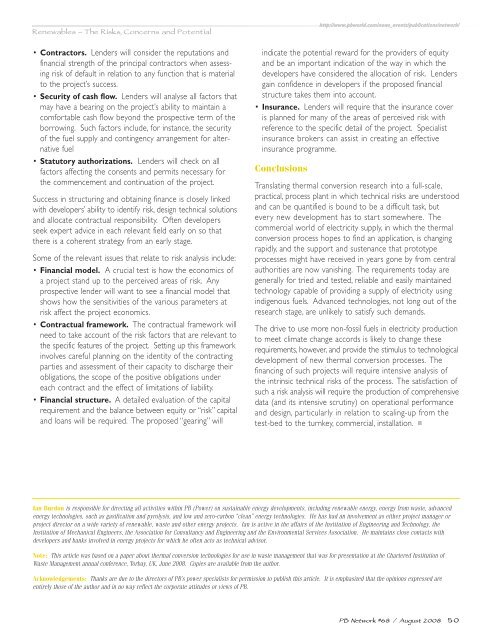Innovation in Global Power - Parsons Brinckerhoff
Innovation in Global Power - Parsons Brinckerhoff
Innovation in Global Power - Parsons Brinckerhoff
You also want an ePaper? Increase the reach of your titles
YUMPU automatically turns print PDFs into web optimized ePapers that Google loves.
Renewables – The Risks, Concerns and Potential<br />
• Contractors. Lenders will consider the reputations and<br />
f<strong>in</strong>ancial strength of the pr<strong>in</strong>cipal contractors when assess<strong>in</strong>g<br />
risk of default <strong>in</strong> relation to any function that is material<br />
to the project’s success.<br />
• Security of cash flow. Lenders will analyse all factors that<br />
may have a bear<strong>in</strong>g on the project’s ability to ma<strong>in</strong>ta<strong>in</strong> a<br />
comfortable cash flow beyond the prospective term of the<br />
borrow<strong>in</strong>g. Such factors <strong>in</strong>clude, for <strong>in</strong>stance, the security<br />
of the fuel supply and cont<strong>in</strong>gency arrangement for alternative<br />
fuel<br />
• Statutory authorizations. Lenders will check on all<br />
factors affect<strong>in</strong>g the consents and permits necessary for<br />
the commencement and cont<strong>in</strong>uation of the project.<br />
Success <strong>in</strong> structur<strong>in</strong>g and obta<strong>in</strong><strong>in</strong>g f<strong>in</strong>ance is closely l<strong>in</strong>ked<br />
with developers’ ability to identify risk, design technical solutions<br />
and allocate contractual responsibility. Often developers<br />
seek expert advice <strong>in</strong> each relevant field early on so that<br />
there is a coherent strategy from an early stage.<br />
Some of the relevant issues that relate to risk analysis <strong>in</strong>clude:<br />
• F<strong>in</strong>ancial model. A crucial test is how the economics of<br />
a project stand up to the perceived areas of risk. Any<br />
prospective lender will want to see a f<strong>in</strong>ancial model that<br />
shows how the sensitivities of the various parameters at<br />
risk affect the project economics.<br />
• Contractual framework. The contractual framework will<br />
need to take account of the risk factors that are relevant to<br />
the specific features of the project. Sett<strong>in</strong>g up this framework<br />
<strong>in</strong>volves careful plann<strong>in</strong>g on the identity of the contract<strong>in</strong>g<br />
parties and assessment of their capacity to discharge their<br />
obligations, the scope of the positive obligations under<br />
each contract and the effect of limitations of liability.<br />
• F<strong>in</strong>ancial structure. A detailed evaluation of the capital<br />
requirement and the balance between equity or “risk” capital<br />
and loans will be required. The proposed “gear<strong>in</strong>g” will<br />
http://www.pbworld.com/news_events/publications/network/<br />
<strong>in</strong>dicate the potential reward for the providers of equity<br />
and be an important <strong>in</strong>dication of the way <strong>in</strong> which the<br />
developers have considered the allocation of risk. Lenders<br />
ga<strong>in</strong> confidence <strong>in</strong> developers if the proposed f<strong>in</strong>ancial<br />
structure takes them <strong>in</strong>to account.<br />
• Insurance. Lenders will require that the <strong>in</strong>surance cover<br />
is planned for many of the areas of perceived risk with<br />
reference to the specific detail of the project. Specialist<br />
<strong>in</strong>surance brokers can assist <strong>in</strong> creat<strong>in</strong>g an effective<br />
<strong>in</strong>surance programme.<br />
Conclusions<br />
Translat<strong>in</strong>g thermal conversion research <strong>in</strong>to a full-scale,<br />
practical, process plant <strong>in</strong> which technical risks are understood<br />
and can be quantified is bound to be a difficult task, but<br />
every new development has to start somewhere. The<br />
commercial world of electricity supply, <strong>in</strong> which the thermal<br />
conversion process hopes to f<strong>in</strong>d an application, is chang<strong>in</strong>g<br />
rapidly, and the support and sustenance that prototype<br />
processes might have received <strong>in</strong> years gone by from central<br />
authorities are now vanish<strong>in</strong>g. The requirements today are<br />
generally for tried and tested, reliable and easily ma<strong>in</strong>ta<strong>in</strong>ed<br />
technology capable of provid<strong>in</strong>g a supply of electricity us<strong>in</strong>g<br />
<strong>in</strong>digenous fuels. Advanced technologies, not long out of the<br />
research stage, are unlikely to satisfy such demands.<br />
The drive to use more non-fossil fuels <strong>in</strong> electricity production<br />
to meet climate change accords is likely to change these<br />
requirements, however, and provide the stimulus to technological<br />
development of new thermal conversion processes. The<br />
f<strong>in</strong>anc<strong>in</strong>g of such projects will require <strong>in</strong>tensive analysis of<br />
the <strong>in</strong>tr<strong>in</strong>sic technical risks of the process. The satisfaction of<br />
such a risk analysis will require the production of comprehensive<br />
data (and its <strong>in</strong>tensive scrut<strong>in</strong>y) on operational performance<br />
and design, particularly <strong>in</strong> relation to scal<strong>in</strong>g-up from the<br />
test-bed to the turnkey, commercial, <strong>in</strong>stallation.<br />
<br />
Ian Burdon is responsible for direct<strong>in</strong>g all activities with<strong>in</strong> PB (<strong>Power</strong>) on susta<strong>in</strong>able energy developments, <strong>in</strong>clud<strong>in</strong>g renewable energy, energy from waste, advanced<br />
energy technologies, such as gasification and pyrolysis, and low and zero-carbon “clean” energy technologies. He has had an <strong>in</strong>volvement as either project manager or<br />
project director on a wide variety of renewable, waste and other energy projects. Ian is active <strong>in</strong> the affairs of the Institution of Eng<strong>in</strong>eer<strong>in</strong>g and Technology, the<br />
Institution of Mechanical Eng<strong>in</strong>eers, the Association for Consultancy and Eng<strong>in</strong>eer<strong>in</strong>g and the Environmental Services Association. He ma<strong>in</strong>ta<strong>in</strong>s close contacts with<br />
developers and banks <strong>in</strong>volved <strong>in</strong> energy projects for which he often acts as technical advisor.<br />
Note: This article was based on a paper about thermal conversion technologies for use <strong>in</strong> waste management that was for presentation at the Chartered Institution of<br />
Waste Management annual conference, Torbay, UK, June 2008. Copies are available from the author.<br />
Acknowledgements: Thanks are due to the directors of PB’s power specialists for permission to publish this article. It is emphasized that the op<strong>in</strong>ions expressed are<br />
entirely those of the author and <strong>in</strong> no way reflect the corporate attitudes or views of PB.<br />
PB Network #68 / August 2008 50

















